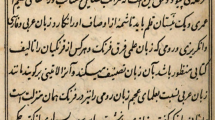Abstract
Europe was the last of the contiguous continents to discover science. The first creative European mathematician was Leonardo Fibonacci, born in the twelfth century. Even Euclid was first translated into Latin, and thus made available to learned people in Western Europe only in the same twelfth century. The Western part of Europe had indeed long ignored not just geometry, but the whole of ancient science. The “discovery” of science happened mainly through a systematic work of translation of Arabic texts, especially in Toledo, Spain, again beginning in the twelfth century. Arabs themselves had translated most texts by Hellenistic scientists from Greek and many Indian texts from Hindi. Thus, Europe discovered science through Islam.
Similar content being viewed by others
Author information
Authors and Affiliations
Corresponding author
Additional information
This article is part of a dossier about the Museum on the History of Arabic Sciences, Muscat.
Rights and permissions
About this article
Cite this article
Greco, P. Translations: How Europe discovered science. Lett Mat Int 4, 105–110 (2016). https://doi.org/10.1007/s40329-016-0137-1
Published:
Issue Date:
DOI: https://doi.org/10.1007/s40329-016-0137-1



